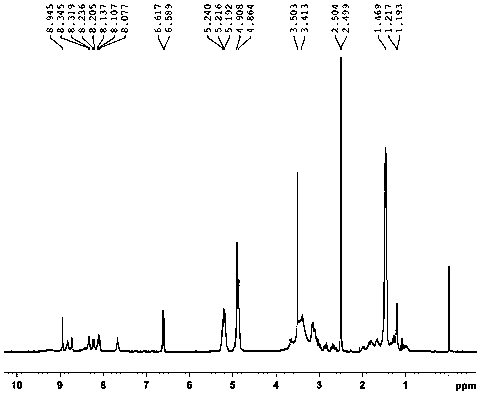T7 peptide-modified active brain targeting nanometer drug delivery system and preparation method thereof
A nano-drug delivery system and brain-targeting technology, applied in the field of medicine, can solve the problems of low BBB permeability of drug molecules and insufficient brain-targeting, and achieve prolonging blood half-life, improving bioavailability and biocompatibility Good results
- Summary
- Abstract
- Description
- Claims
- Application Information
AI Technical Summary
Problems solved by technology
Method used
Image
Examples
Embodiment 1
[0033] Example 1 Preparation of carrier PEG-PLGA
[0034] Weigh 250 mg PLGA-COOH and dissolve in 2 ml dichloromethane, then add 10.78 mg DMAP (PLGA:DMAP1:6, molar ratio), 10.15 mg NHS (PLGA:NHS 1:6, molar ratio) and 18.2 mg DCC (PLGA:DCC 1:6, molar ratio), in nitrogen N 2 Stir at room temperature for 24 h under protection. After the reaction, dicyclohexyl urea (DCU) was removed by filtration, and the filtrate was slowly added dropwise to 10 ml of ice anhydrous ether, and the precipitated PLGA-NHS was washed three times with a mixture of ice ether and methanol to remove unreacted NHS and DCC. The solvent was dried under vacuum at a temperature of 60°C for 4 hours, and the obtained polymer was re-dissolved with 2 ml of dichloromethane, and then 33.2 mg of MAL-PEG-NH2 (1:1.3 PLGA:PEG molar ratio) and 3 drops of N,N- Diisopropylethylamine (DPIEA), under nitrogen N 2 Stir and react for 12 hours under guaranteed conditions, slowly add the solution dropwise to 10 ml of ice-free a...
Embodiment 2
[0035] Example 2 Preparation of Tanshinone IIA PEG-PLGA Nanoparticles Encapsulated
[0036] Weigh 30 mg PEG-PLGA and 2 mg tanshinone IIA and dissolve in 2.0 mL of the mixed organic phase of dichloromethane and acetone (acetone: dichloromethane = 1:9 v / v), and add it to 20ml In an aqueous solution with a mass fraction of 0.5% PVA, in an ice-water bath, 250W ultrasonication for 10s, intermittent 10s, ultrasonication for 15min, stirring at 600 r / min for 5h to evaporate the organic solvent contained in the solution, and then high-speed centrifugation at 14000 r / min for 30min
[0037] Repeatedly washed three times with ultrapure water to remove the emulsifier in the nanoparticle suspension solution, filtered through a 0.22 μm microporous membrane, and then freeze-dried to obtain PEG-PLGA nanoparticles loaded with tanshinone IIA and blank PEG-PLGA nanoparticles. Granules (PEG-PLGA-NPs) were prepared as described above.
Embodiment 3
[0038] Example 3 Preparation of T7 peptide modified PEG-PLGA brain targeting nanocarrier
[0039] Reconstitute 20 mg of blank PEG-PLGA nanoparticles with PBS (PH=7.0) solution, add 1 mg of T7 peptide, the molar ratio of T7 peptide to PEG-PLGA is 1: 1, and stir for 24 hours in the dark, and the unreacted T7 peptide passes through The dialysis bag (MWCO: 5KDa) was removed in PBS (pH 7.0) buffer, and the solution after dialysis was freeze-dried to prepare T7-PEG-PLGA brain-targeted nanocarriers, which were characterized by H NMR spectroscopy. The results are as follows: image 3 shown.
PUM
| Property | Measurement | Unit |
|---|---|---|
| Quality score | aaaaa | aaaaa |
Abstract
Description
Claims
Application Information
 Login to View More
Login to View More - Generate Ideas
- Intellectual Property
- Life Sciences
- Materials
- Tech Scout
- Unparalleled Data Quality
- Higher Quality Content
- 60% Fewer Hallucinations
Browse by: Latest US Patents, China's latest patents, Technical Efficacy Thesaurus, Application Domain, Technology Topic, Popular Technical Reports.
© 2025 PatSnap. All rights reserved.Legal|Privacy policy|Modern Slavery Act Transparency Statement|Sitemap|About US| Contact US: help@patsnap.com



